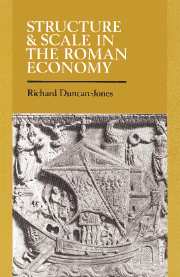Book contents
- Frontmatter
- Contents
- List of figures
- List of tables
- Preface
- List of abbreviations
- Introduction
- PART I TIME AND DISTANCE
- PART II DEMOGRAPHY AND MANPOWER
- PART III AGRARIAN PATTERNS
- 8 Land and landed wealth
- 9 The price of wheat in Roman Egypt
- PART IV THE WORLD OF CITIES
- PART V TAX-PAYMENT AND TAX-ASSESSMENT
- Appendices
- Bibliography
- Index
8 - Land and landed wealth
Published online by Cambridge University Press: 13 October 2009
- Frontmatter
- Contents
- List of figures
- List of tables
- Preface
- List of abbreviations
- Introduction
- PART I TIME AND DISTANCE
- PART II DEMOGRAPHY AND MANPOWER
- PART III AGRARIAN PATTERNS
- 8 Land and landed wealth
- 9 The price of wheat in Roman Egypt
- PART IV THE WORLD OF CITIES
- PART V TAX-PAYMENT AND TAX-ASSESSMENT
- Appendices
- Bibliography
- Index
Summary
A detailed map of landholding in the Roman world would show many differences. We should see state land, imperial land and city land, as well as a host of properties of different size in full private ownership. This chapter briefly considers juridical differences before investigating the underlying reality of landholding patterns. Because of the layout of the evidence, an exhaustive treatment would be strongly biassed towards Egypt, but a wider approach is possible in a short discussion.
Ager publicus
Land generally fell into one of six categories (if the nuances of legal title and the more complex situation in Egypt are set on one side). The first type is ager publicus, land belonging to the populus Romanus, the Roman state. Such land, if cultivated, was generally in the hands of private tenants of the state. The extent of ager publicus was originally immense, since Rome normally expropriated the land of conquered peoples, at any rate in theory. But the amount diminished as cultivable land was gradually assigned to veterans, civilian colonists or purchasers. As late as Trajan's time, ager publicus made up almost a quarter (22%) of peripheral holdings in a list of lands owned by private individuals and cities at Veleia in the far north of Italy. Not all of it was necessarily cultivated, since Veleia lay in a mountainous and infertile region; some may have been pasture. In a similar list from Ligures Baebiani in southern Italy, ager publicus forms 10% of peripheral holdings.
- Type
- Chapter
- Information
- Structure and Scale in the Roman Economy , pp. 121 - 142Publisher: Cambridge University PressPrint publication year: 1990
- 2
- Cited by



